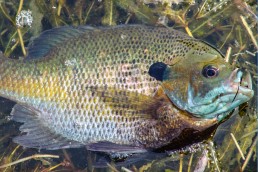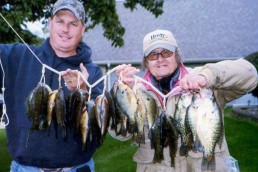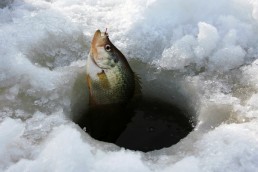Springtime is the Best Time for Big Bull Bluegills
SHARE THIS POST
With sunny mornings, spring in the air and summer just around the corner, my thoughts turn from the recent turkey season to walleyes, smallmouth bass, northern pike, and one of my favorite target species—the lowly and underrated bluegill. Prolific breeders, the spiny little brats fill up most ponds and lakes. But do not take them for granted; they can be as finicky as any other fish.
My spring forays in search of ‘gills always begins in one or two of the nearby small ponds where I have permission to fish. As well, I own a small pond of my own that usually yields a mess or two when I want them. My nephew owns two and my sister owns one, all within several hundred yards of each other. Finding a place to fish is not a challenge for me. But, catching the little nippers can be.
In June, the warming of the waters stimulates the annual mating ritual of most finny creatures, including the bluegill. Concurrently, they also will be focused on feeding and keeping from being an item on a larger predator’s menu. The fish will be found in a bit shallower waters than they were when you were ice fishing. [Author’s note: this last bitterly cold winter produced some great ice fishing in Michigan as well as on Lake Erie. More on that in a later article]. Therefore, this is where you should begin your search.
The males may well be shallower than the females at this point since the responsibility for fanning out nesting beds with their broad tails falls upon them. Depths of about four to five feet are probably appropriate.
To my way of thinking, there are no better baits at this time of year than wax worms and/or red worms, a.k.a. tigers. Select a light-action casting, spinning, or spin casting outfit, and spool it with 6-pound-test line. Choose a #8 long shanked Daiichi red, light wire hook and a small, round bobber or a slip bobber and you have the basics for catching a mess of fish. Should you care to opt for artificial lures, tie on the smallest Road Runner that you can find, tip it with a bit of red worm, cast it out and wind it in. These are dynamite little lures.
Are you enjoying this post?
You can be among the first to get the latest info on where to go, what to use and how to use it!
Strikes in June should be pretty lively; the bobber will dip, or go sideways violently. A hard hook set is not required, wind the slack out of the line and quickly raise the rod tip; the fish should be hooked in the upper lip. Bluegills are notorious for swallowing the hook when live bait is utilized, so be sure to have a pair of needle nosed pliers handy for retrieving the hook. If the hook is embedded too deeply, cut the line, tie on another hook and retrieve the hook later while cleaning the fish. It is a good idea to have an old rag in your back pocket to clean your hands after removing a hook.
Voracious bluegills on the feed are not picky. I have taken them on all sorts of fly rod “bugs” and poppers, spinner baits, jigs, wooden and plastic bass plugs and even on six-inch plastic worms. The very fact that they will hit something this large shows just how aggressive they can be.
So, where will they be found? Somewhere near where they spawned last year. Over sand or gravel beaches, on the edges of gravel points that taper down into the water, or near any underwater humps that provide a suitable spawning ground.
As mentioned earlier begin your search in about five feet of water. No takers? Move shallower until you are in about two feet of water. Any of the above areas that are bordered by brush, downed trees or weed beds should be bluegill magnets.
As much as I enjoy catching bluegills, I enjoy eating them more. I’ll bet you do too. Catch a lot, take some pictures, keep enough for a meal or two and release the rest.
MWO
SHARE THIS POST
Did you enjoy this post?
You can be among the first to get the latest info on where to go, what to use and how to use it!
John Bennett
John Bennett is a retired history teacher, historical re-enactor, father and grandfather. As a four-season outdoorsman, his passion is waterfowl hunting and fishing for smallmouth bass. He lives in Ohio and spends quite a bit of time in his primitive log cabin, which he built.



